An Analysis of the Correlation Between Race and Economic Inequality
VerifiedAdded on 2021/06/17
|8
|2099
|81
Literature Review
AI Summary
This literature review examines the multifaceted relationship between race and economic inequality in the United States, drawing on various sources, including academic articles, surveys, and reports from organizations like the United Nations. The review explores key factors contributing to the racial wealth gap, such as homeownership, education, poverty, and unemployment, highlighting the systemic disadvantages faced by people of color. It analyzes how racial discrimination impacts access to quality education, employment opportunities, and financial stability, leading to persistent disparities in income, wealth accumulation, and overall well-being. The review also examines the impact of racism on women and health, with a particular focus on the intersection of race, poverty, and health outcomes. The analysis includes discussion of the methodologies employed in the reviewed studies, including surveys, databases, and reports, as well as the strengths and weaknesses of each approach. The review concludes by emphasizing the urgent need to address racial discrimination and its economic consequences, proposing that future research should focus on identifying effective preventive measures to mitigate these disparities.
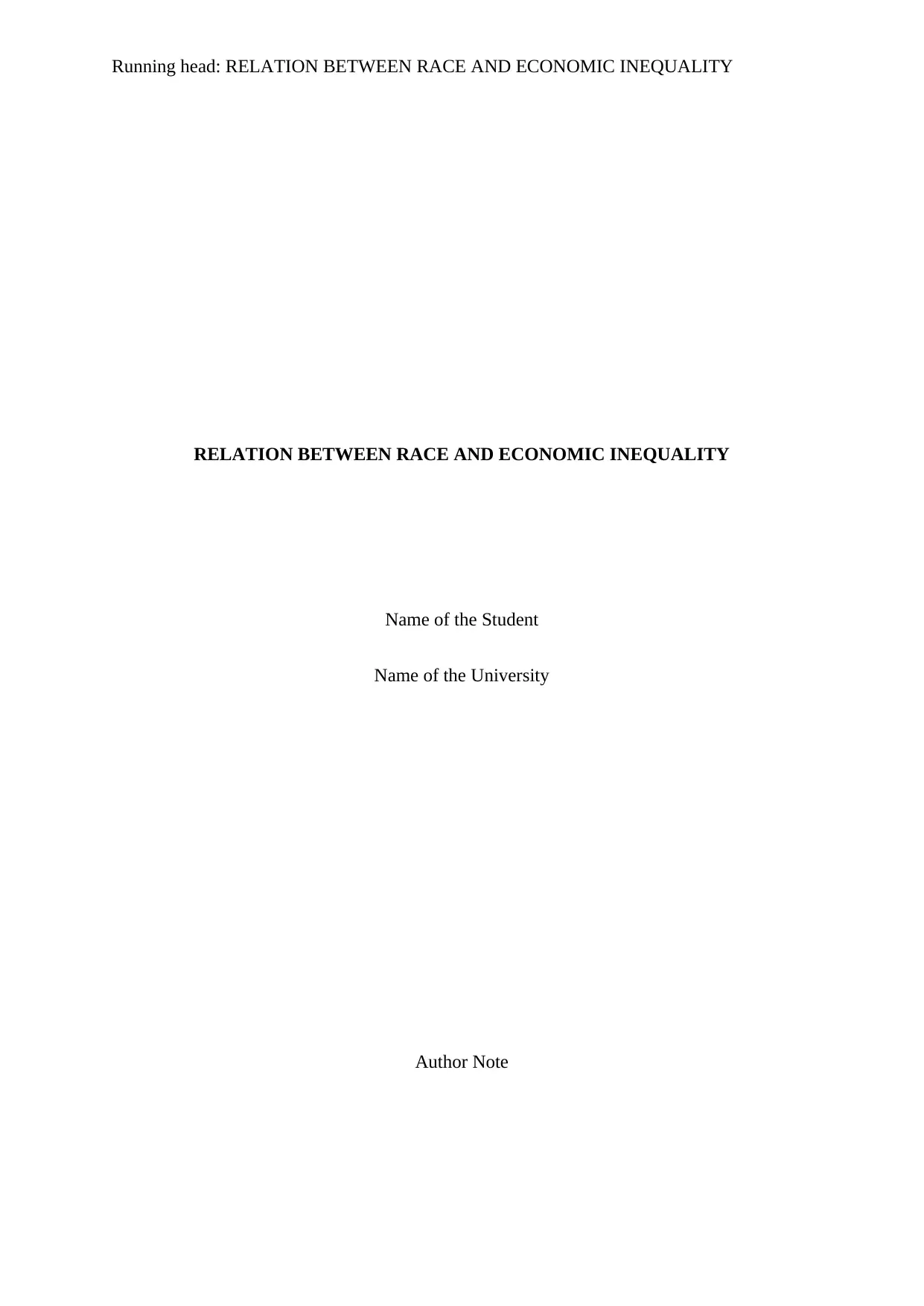
Running head: RELATION BETWEEN RACE AND ECONOMIC INEQUALITY
RELATION BETWEEN RACE AND ECONOMIC INEQUALITY
Name of the Student
Name of the University
Author Note
RELATION BETWEEN RACE AND ECONOMIC INEQUALITY
Name of the Student
Name of the University
Author Note
Paraphrase This Document
Need a fresh take? Get an instant paraphrase of this document with our AI Paraphraser
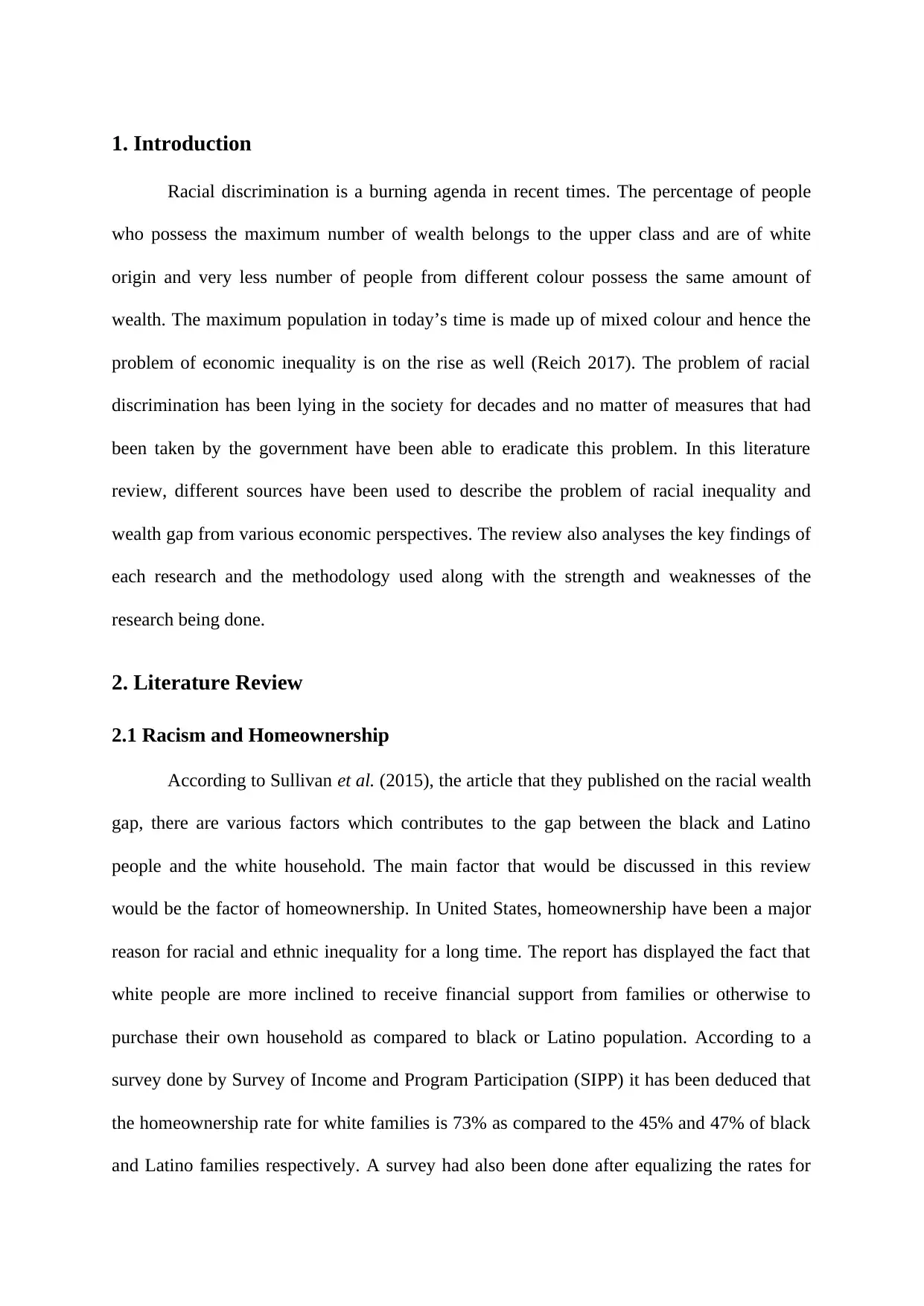
1. Introduction
Racial discrimination is a burning agenda in recent times. The percentage of people
who possess the maximum number of wealth belongs to the upper class and are of white
origin and very less number of people from different colour possess the same amount of
wealth. The maximum population in today’s time is made up of mixed colour and hence the
problem of economic inequality is on the rise as well (Reich 2017). The problem of racial
discrimination has been lying in the society for decades and no matter of measures that had
been taken by the government have been able to eradicate this problem. In this literature
review, different sources have been used to describe the problem of racial inequality and
wealth gap from various economic perspectives. The review also analyses the key findings of
each research and the methodology used along with the strength and weaknesses of the
research being done.
2. Literature Review
2.1 Racism and Homeownership
According to Sullivan et al. (2015), the article that they published on the racial wealth
gap, there are various factors which contributes to the gap between the black and Latino
people and the white household. The main factor that would be discussed in this review
would be the factor of homeownership. In United States, homeownership have been a major
reason for racial and ethnic inequality for a long time. The report has displayed the fact that
white people are more inclined to receive financial support from families or otherwise to
purchase their own household as compared to black or Latino population. According to a
survey done by Survey of Income and Program Participation (SIPP) it has been deduced that
the homeownership rate for white families is 73% as compared to the 45% and 47% of black
and Latino families respectively. A survey had also been done after equalizing the rates for
Racial discrimination is a burning agenda in recent times. The percentage of people
who possess the maximum number of wealth belongs to the upper class and are of white
origin and very less number of people from different colour possess the same amount of
wealth. The maximum population in today’s time is made up of mixed colour and hence the
problem of economic inequality is on the rise as well (Reich 2017). The problem of racial
discrimination has been lying in the society for decades and no matter of measures that had
been taken by the government have been able to eradicate this problem. In this literature
review, different sources have been used to describe the problem of racial inequality and
wealth gap from various economic perspectives. The review also analyses the key findings of
each research and the methodology used along with the strength and weaknesses of the
research being done.
2. Literature Review
2.1 Racism and Homeownership
According to Sullivan et al. (2015), the article that they published on the racial wealth
gap, there are various factors which contributes to the gap between the black and Latino
people and the white household. The main factor that would be discussed in this review
would be the factor of homeownership. In United States, homeownership have been a major
reason for racial and ethnic inequality for a long time. The report has displayed the fact that
white people are more inclined to receive financial support from families or otherwise to
purchase their own household as compared to black or Latino population. According to a
survey done by Survey of Income and Program Participation (SIPP) it has been deduced that
the homeownership rate for white families is 73% as compared to the 45% and 47% of black
and Latino families respectively. A survey had also been done after equalizing the rates for
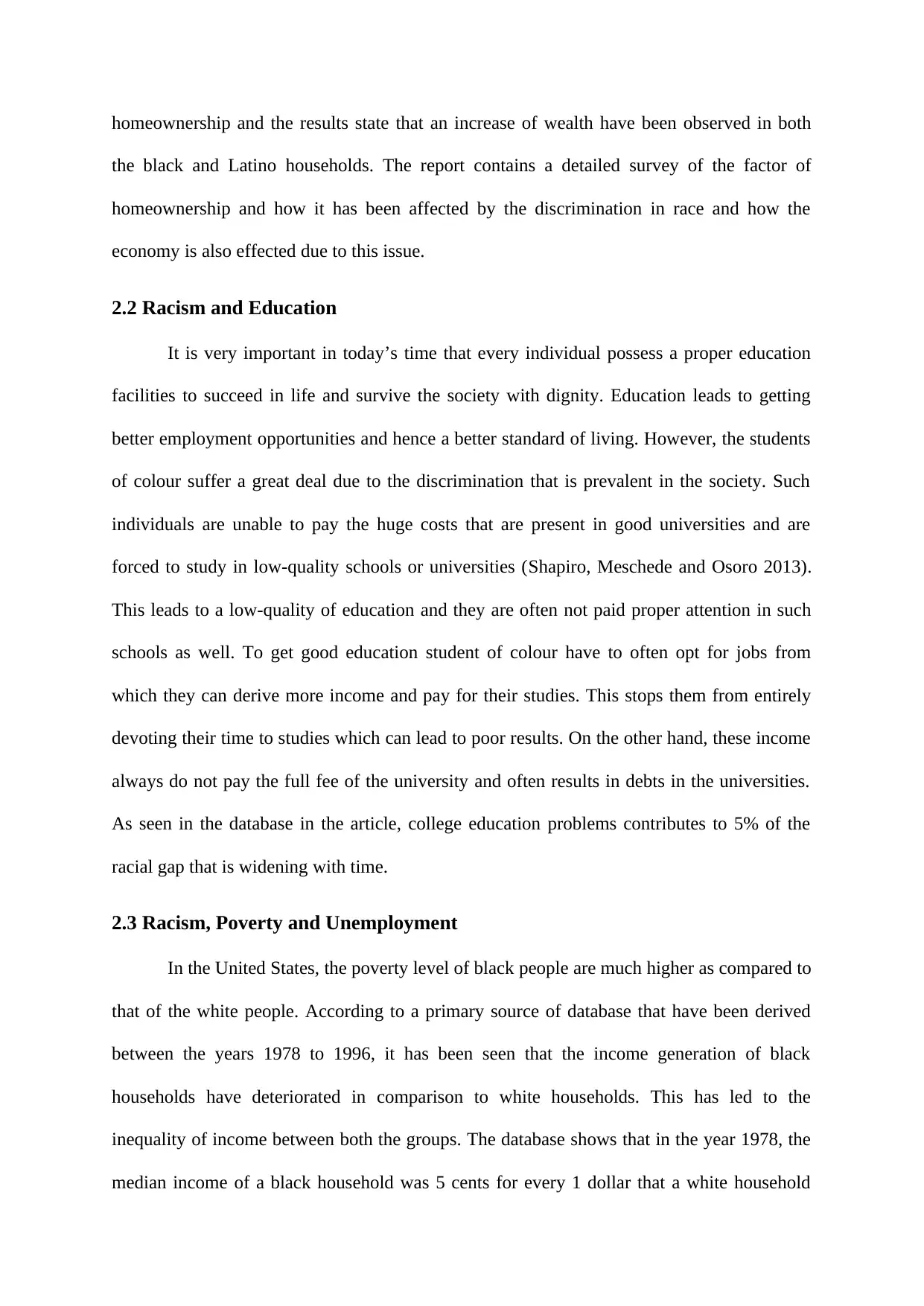
homeownership and the results state that an increase of wealth have been observed in both
the black and Latino households. The report contains a detailed survey of the factor of
homeownership and how it has been affected by the discrimination in race and how the
economy is also effected due to this issue.
2.2 Racism and Education
It is very important in today’s time that every individual possess a proper education
facilities to succeed in life and survive the society with dignity. Education leads to getting
better employment opportunities and hence a better standard of living. However, the students
of colour suffer a great deal due to the discrimination that is prevalent in the society. Such
individuals are unable to pay the huge costs that are present in good universities and are
forced to study in low-quality schools or universities (Shapiro, Meschede and Osoro 2013).
This leads to a low-quality of education and they are often not paid proper attention in such
schools as well. To get good education student of colour have to often opt for jobs from
which they can derive more income and pay for their studies. This stops them from entirely
devoting their time to studies which can lead to poor results. On the other hand, these income
always do not pay the full fee of the university and often results in debts in the universities.
As seen in the database in the article, college education problems contributes to 5% of the
racial gap that is widening with time.
2.3 Racism, Poverty and Unemployment
In the United States, the poverty level of black people are much higher as compared to
that of the white people. According to a primary source of database that have been derived
between the years 1978 to 1996, it has been seen that the income generation of black
households have deteriorated in comparison to white households. This has led to the
inequality of income between both the groups. The database shows that in the year 1978, the
median income of a black household was 5 cents for every 1 dollar that a white household
the black and Latino households. The report contains a detailed survey of the factor of
homeownership and how it has been affected by the discrimination in race and how the
economy is also effected due to this issue.
2.2 Racism and Education
It is very important in today’s time that every individual possess a proper education
facilities to succeed in life and survive the society with dignity. Education leads to getting
better employment opportunities and hence a better standard of living. However, the students
of colour suffer a great deal due to the discrimination that is prevalent in the society. Such
individuals are unable to pay the huge costs that are present in good universities and are
forced to study in low-quality schools or universities (Shapiro, Meschede and Osoro 2013).
This leads to a low-quality of education and they are often not paid proper attention in such
schools as well. To get good education student of colour have to often opt for jobs from
which they can derive more income and pay for their studies. This stops them from entirely
devoting their time to studies which can lead to poor results. On the other hand, these income
always do not pay the full fee of the university and often results in debts in the universities.
As seen in the database in the article, college education problems contributes to 5% of the
racial gap that is widening with time.
2.3 Racism, Poverty and Unemployment
In the United States, the poverty level of black people are much higher as compared to
that of the white people. According to a primary source of database that have been derived
between the years 1978 to 1996, it has been seen that the income generation of black
households have deteriorated in comparison to white households. This has led to the
inequality of income between both the groups. The database shows that in the year 1978, the
median income of a black household was 5 cents for every 1 dollar that a white household
⊘ This is a preview!⊘
Do you want full access?
Subscribe today to unlock all pages.

Trusted by 1+ million students worldwide
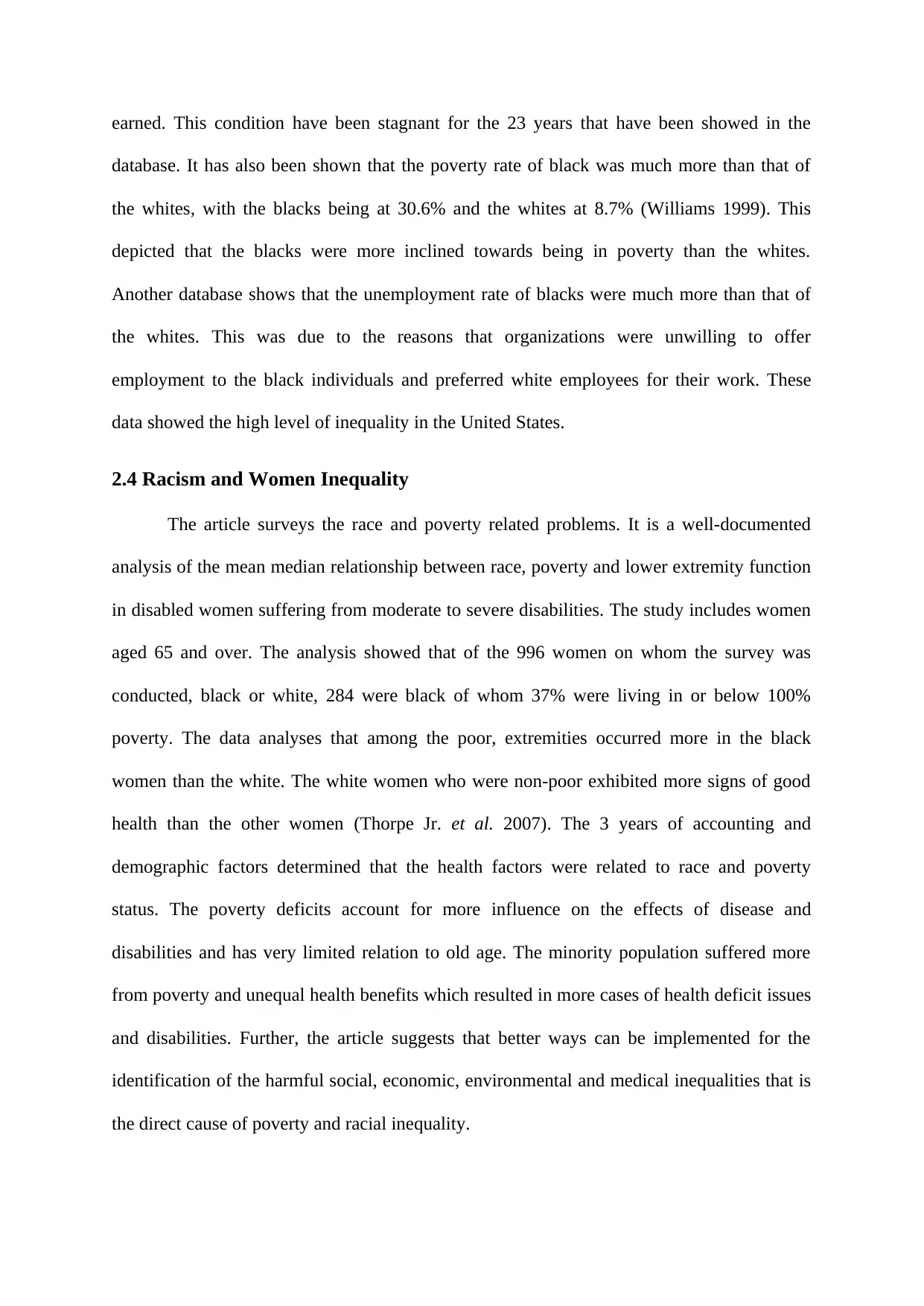
earned. This condition have been stagnant for the 23 years that have been showed in the
database. It has also been shown that the poverty rate of black was much more than that of
the whites, with the blacks being at 30.6% and the whites at 8.7% (Williams 1999). This
depicted that the blacks were more inclined towards being in poverty than the whites.
Another database shows that the unemployment rate of blacks were much more than that of
the whites. This was due to the reasons that organizations were unwilling to offer
employment to the black individuals and preferred white employees for their work. These
data showed the high level of inequality in the United States.
2.4 Racism and Women Inequality
The article surveys the race and poverty related problems. It is a well-documented
analysis of the mean median relationship between race, poverty and lower extremity function
in disabled women suffering from moderate to severe disabilities. The study includes women
aged 65 and over. The analysis showed that of the 996 women on whom the survey was
conducted, black or white, 284 were black of whom 37% were living in or below 100%
poverty. The data analyses that among the poor, extremities occurred more in the black
women than the white. The white women who were non-poor exhibited more signs of good
health than the other women (Thorpe Jr. et al. 2007). The 3 years of accounting and
demographic factors determined that the health factors were related to race and poverty
status. The poverty deficits account for more influence on the effects of disease and
disabilities and has very limited relation to old age. The minority population suffered more
from poverty and unequal health benefits which resulted in more cases of health deficit issues
and disabilities. Further, the article suggests that better ways can be implemented for the
identification of the harmful social, economic, environmental and medical inequalities that is
the direct cause of poverty and racial inequality.
database. It has also been shown that the poverty rate of black was much more than that of
the whites, with the blacks being at 30.6% and the whites at 8.7% (Williams 1999). This
depicted that the blacks were more inclined towards being in poverty than the whites.
Another database shows that the unemployment rate of blacks were much more than that of
the whites. This was due to the reasons that organizations were unwilling to offer
employment to the black individuals and preferred white employees for their work. These
data showed the high level of inequality in the United States.
2.4 Racism and Women Inequality
The article surveys the race and poverty related problems. It is a well-documented
analysis of the mean median relationship between race, poverty and lower extremity function
in disabled women suffering from moderate to severe disabilities. The study includes women
aged 65 and over. The analysis showed that of the 996 women on whom the survey was
conducted, black or white, 284 were black of whom 37% were living in or below 100%
poverty. The data analyses that among the poor, extremities occurred more in the black
women than the white. The white women who were non-poor exhibited more signs of good
health than the other women (Thorpe Jr. et al. 2007). The 3 years of accounting and
demographic factors determined that the health factors were related to race and poverty
status. The poverty deficits account for more influence on the effects of disease and
disabilities and has very limited relation to old age. The minority population suffered more
from poverty and unequal health benefits which resulted in more cases of health deficit issues
and disabilities. Further, the article suggests that better ways can be implemented for the
identification of the harmful social, economic, environmental and medical inequalities that is
the direct cause of poverty and racial inequality.
Paraphrase This Document
Need a fresh take? Get an instant paraphrase of this document with our AI Paraphraser
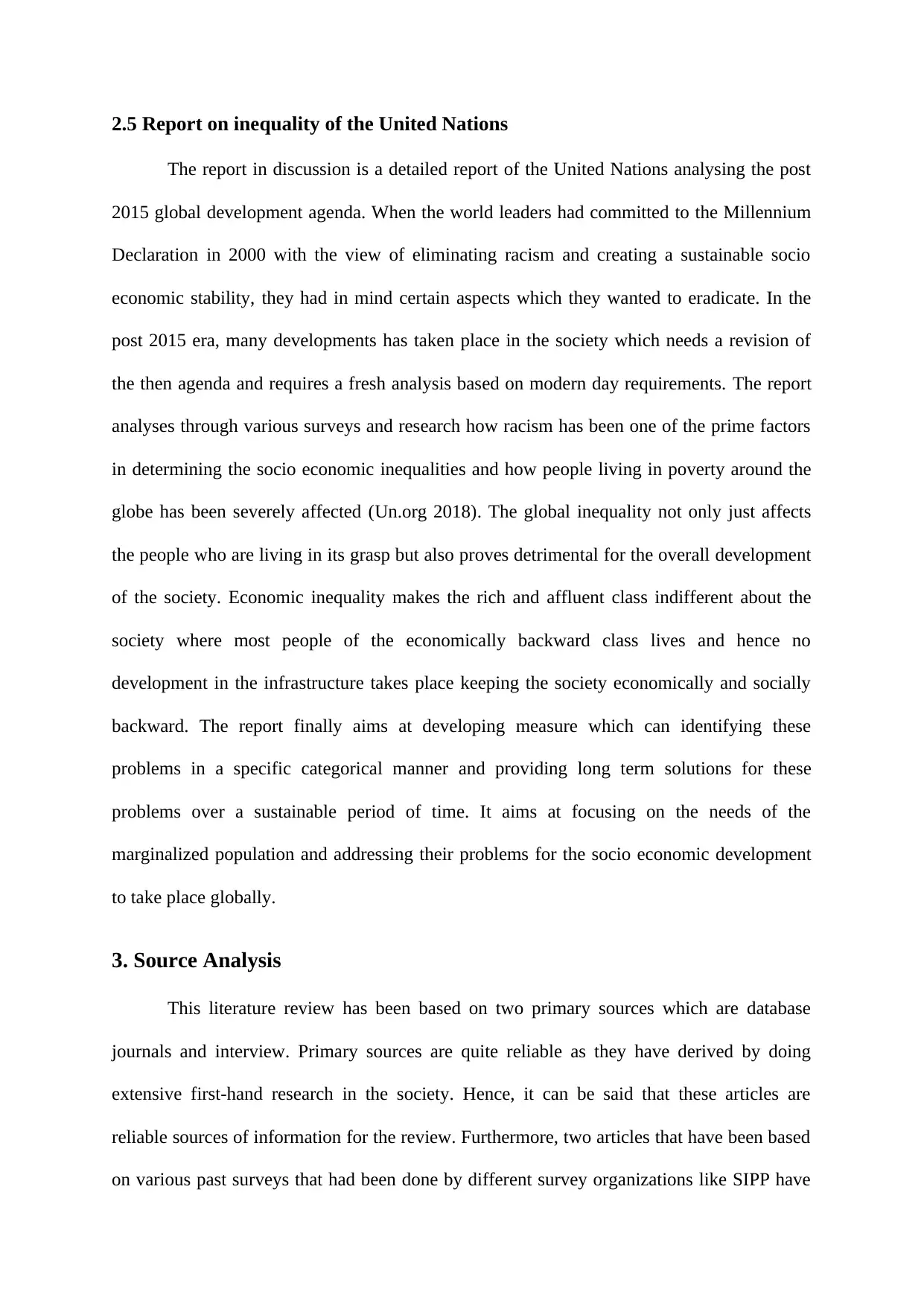
2.5 Report on inequality of the United Nations
The report in discussion is a detailed report of the United Nations analysing the post
2015 global development agenda. When the world leaders had committed to the Millennium
Declaration in 2000 with the view of eliminating racism and creating a sustainable socio
economic stability, they had in mind certain aspects which they wanted to eradicate. In the
post 2015 era, many developments has taken place in the society which needs a revision of
the then agenda and requires a fresh analysis based on modern day requirements. The report
analyses through various surveys and research how racism has been one of the prime factors
in determining the socio economic inequalities and how people living in poverty around the
globe has been severely affected (Un.org 2018). The global inequality not only just affects
the people who are living in its grasp but also proves detrimental for the overall development
of the society. Economic inequality makes the rich and affluent class indifferent about the
society where most people of the economically backward class lives and hence no
development in the infrastructure takes place keeping the society economically and socially
backward. The report finally aims at developing measure which can identifying these
problems in a specific categorical manner and providing long term solutions for these
problems over a sustainable period of time. It aims at focusing on the needs of the
marginalized population and addressing their problems for the socio economic development
to take place globally.
3. Source Analysis
This literature review has been based on two primary sources which are database
journals and interview. Primary sources are quite reliable as they have derived by doing
extensive first-hand research in the society. Hence, it can be said that these articles are
reliable sources of information for the review. Furthermore, two articles that have been based
on various past surveys that had been done by different survey organizations like SIPP have
The report in discussion is a detailed report of the United Nations analysing the post
2015 global development agenda. When the world leaders had committed to the Millennium
Declaration in 2000 with the view of eliminating racism and creating a sustainable socio
economic stability, they had in mind certain aspects which they wanted to eradicate. In the
post 2015 era, many developments has taken place in the society which needs a revision of
the then agenda and requires a fresh analysis based on modern day requirements. The report
analyses through various surveys and research how racism has been one of the prime factors
in determining the socio economic inequalities and how people living in poverty around the
globe has been severely affected (Un.org 2018). The global inequality not only just affects
the people who are living in its grasp but also proves detrimental for the overall development
of the society. Economic inequality makes the rich and affluent class indifferent about the
society where most people of the economically backward class lives and hence no
development in the infrastructure takes place keeping the society economically and socially
backward. The report finally aims at developing measure which can identifying these
problems in a specific categorical manner and providing long term solutions for these
problems over a sustainable period of time. It aims at focusing on the needs of the
marginalized population and addressing their problems for the socio economic development
to take place globally.
3. Source Analysis
This literature review has been based on two primary sources which are database
journals and interview. Primary sources are quite reliable as they have derived by doing
extensive first-hand research in the society. Hence, it can be said that these articles are
reliable sources of information for the review. Furthermore, two articles that have been based
on various past surveys that had been done by different survey organizations like SIPP have
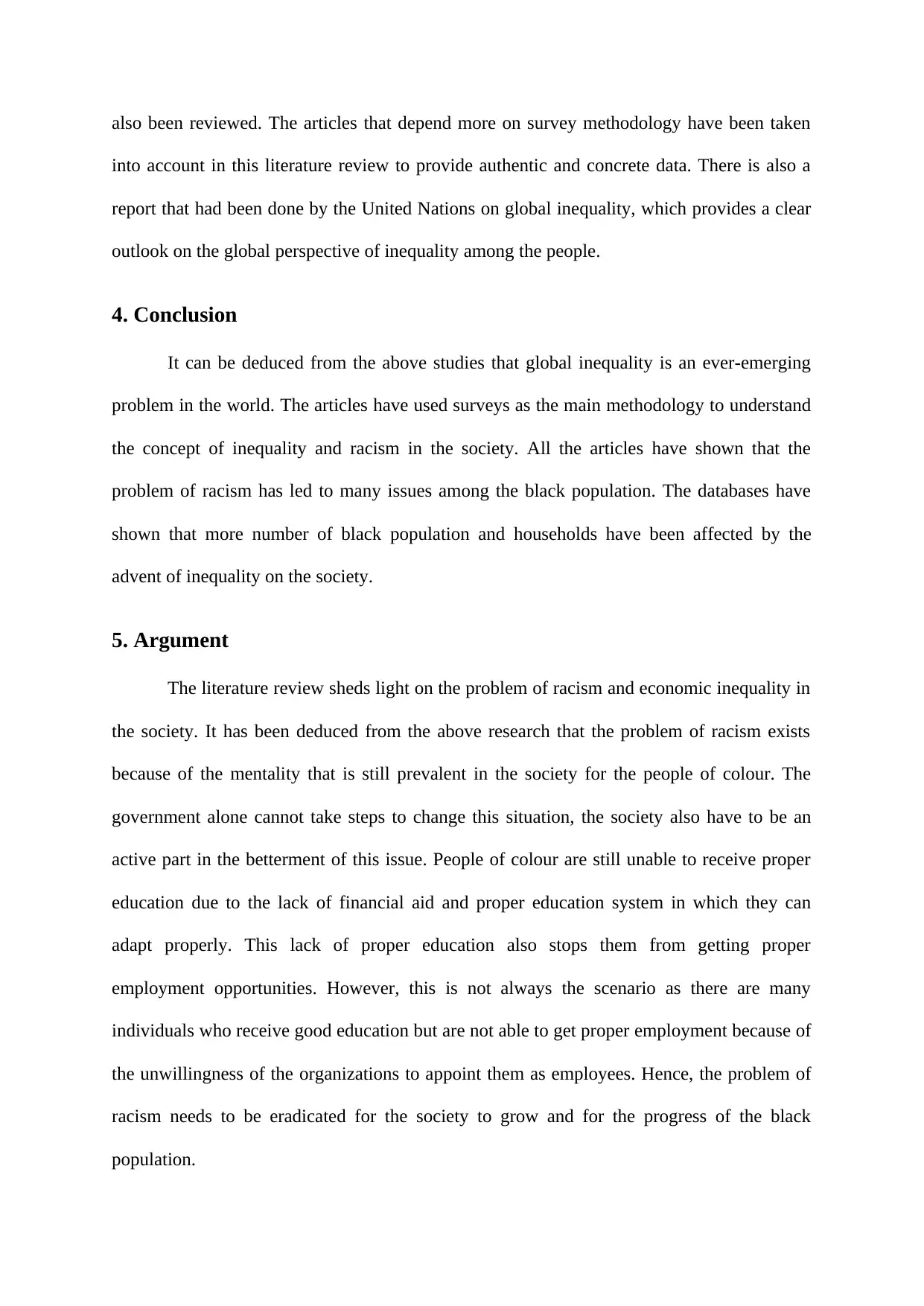
also been reviewed. The articles that depend more on survey methodology have been taken
into account in this literature review to provide authentic and concrete data. There is also a
report that had been done by the United Nations on global inequality, which provides a clear
outlook on the global perspective of inequality among the people.
4. Conclusion
It can be deduced from the above studies that global inequality is an ever-emerging
problem in the world. The articles have used surveys as the main methodology to understand
the concept of inequality and racism in the society. All the articles have shown that the
problem of racism has led to many issues among the black population. The databases have
shown that more number of black population and households have been affected by the
advent of inequality on the society.
5. Argument
The literature review sheds light on the problem of racism and economic inequality in
the society. It has been deduced from the above research that the problem of racism exists
because of the mentality that is still prevalent in the society for the people of colour. The
government alone cannot take steps to change this situation, the society also have to be an
active part in the betterment of this issue. People of colour are still unable to receive proper
education due to the lack of financial aid and proper education system in which they can
adapt properly. This lack of proper education also stops them from getting proper
employment opportunities. However, this is not always the scenario as there are many
individuals who receive good education but are not able to get proper employment because of
the unwillingness of the organizations to appoint them as employees. Hence, the problem of
racism needs to be eradicated for the society to grow and for the progress of the black
population.
into account in this literature review to provide authentic and concrete data. There is also a
report that had been done by the United Nations on global inequality, which provides a clear
outlook on the global perspective of inequality among the people.
4. Conclusion
It can be deduced from the above studies that global inequality is an ever-emerging
problem in the world. The articles have used surveys as the main methodology to understand
the concept of inequality and racism in the society. All the articles have shown that the
problem of racism has led to many issues among the black population. The databases have
shown that more number of black population and households have been affected by the
advent of inequality on the society.
5. Argument
The literature review sheds light on the problem of racism and economic inequality in
the society. It has been deduced from the above research that the problem of racism exists
because of the mentality that is still prevalent in the society for the people of colour. The
government alone cannot take steps to change this situation, the society also have to be an
active part in the betterment of this issue. People of colour are still unable to receive proper
education due to the lack of financial aid and proper education system in which they can
adapt properly. This lack of proper education also stops them from getting proper
employment opportunities. However, this is not always the scenario as there are many
individuals who receive good education but are not able to get proper employment because of
the unwillingness of the organizations to appoint them as employees. Hence, the problem of
racism needs to be eradicated for the society to grow and for the progress of the black
population.
⊘ This is a preview!⊘
Do you want full access?
Subscribe today to unlock all pages.

Trusted by 1+ million students worldwide
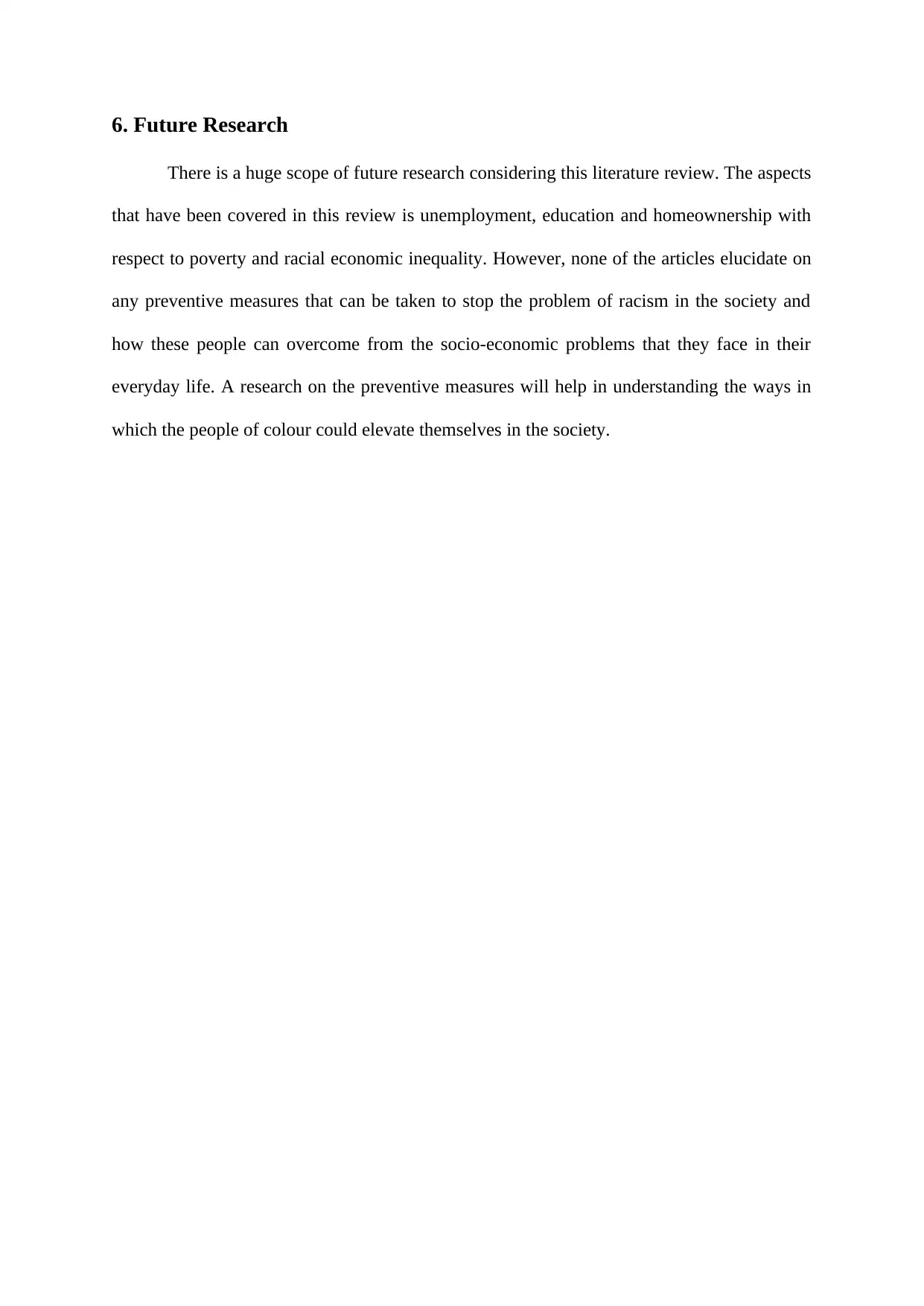
6. Future Research
There is a huge scope of future research considering this literature review. The aspects
that have been covered in this review is unemployment, education and homeownership with
respect to poverty and racial economic inequality. However, none of the articles elucidate on
any preventive measures that can be taken to stop the problem of racism in the society and
how these people can overcome from the socio-economic problems that they face in their
everyday life. A research on the preventive measures will help in understanding the ways in
which the people of colour could elevate themselves in the society.
There is a huge scope of future research considering this literature review. The aspects
that have been covered in this review is unemployment, education and homeownership with
respect to poverty and racial economic inequality. However, none of the articles elucidate on
any preventive measures that can be taken to stop the problem of racism in the society and
how these people can overcome from the socio-economic problems that they face in their
everyday life. A research on the preventive measures will help in understanding the ways in
which the people of colour could elevate themselves in the society.
Paraphrase This Document
Need a fresh take? Get an instant paraphrase of this document with our AI Paraphraser
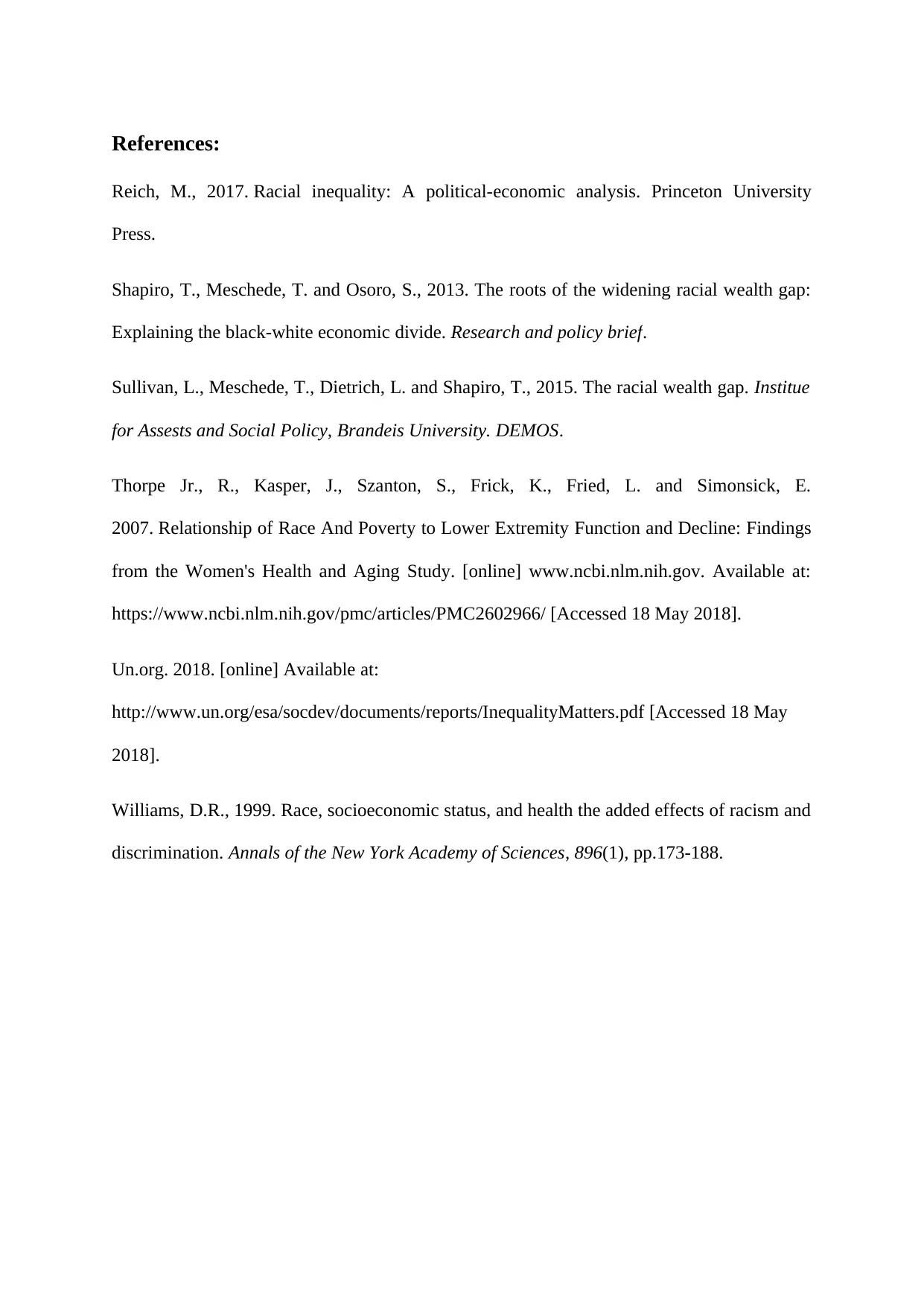
References:
Reich, M., 2017. Racial inequality: A political-economic analysis. Princeton University
Press.
Shapiro, T., Meschede, T. and Osoro, S., 2013. The roots of the widening racial wealth gap:
Explaining the black-white economic divide. Research and policy brief.
Sullivan, L., Meschede, T., Dietrich, L. and Shapiro, T., 2015. The racial wealth gap. Institue
for Assests and Social Policy, Brandeis University. DEMOS.
Thorpe Jr., R., Kasper, J., Szanton, S., Frick, K., Fried, L. and Simonsick, E.
2007. Relationship of Race And Poverty to Lower Extremity Function and Decline: Findings
from the Women's Health and Aging Study. [online] www.ncbi.nlm.nih.gov. Available at:
https://www.ncbi.nlm.nih.gov/pmc/articles/PMC2602966/ [Accessed 18 May 2018].
Un.org. 2018. [online] Available at:
http://www.un.org/esa/socdev/documents/reports/InequalityMatters.pdf [Accessed 18 May
2018].
Williams, D.R., 1999. Race, socioeconomic status, and health the added effects of racism and
discrimination. Annals of the New York Academy of Sciences, 896(1), pp.173-188.
Reich, M., 2017. Racial inequality: A political-economic analysis. Princeton University
Press.
Shapiro, T., Meschede, T. and Osoro, S., 2013. The roots of the widening racial wealth gap:
Explaining the black-white economic divide. Research and policy brief.
Sullivan, L., Meschede, T., Dietrich, L. and Shapiro, T., 2015. The racial wealth gap. Institue
for Assests and Social Policy, Brandeis University. DEMOS.
Thorpe Jr., R., Kasper, J., Szanton, S., Frick, K., Fried, L. and Simonsick, E.
2007. Relationship of Race And Poverty to Lower Extremity Function and Decline: Findings
from the Women's Health and Aging Study. [online] www.ncbi.nlm.nih.gov. Available at:
https://www.ncbi.nlm.nih.gov/pmc/articles/PMC2602966/ [Accessed 18 May 2018].
Un.org. 2018. [online] Available at:
http://www.un.org/esa/socdev/documents/reports/InequalityMatters.pdf [Accessed 18 May
2018].
Williams, D.R., 1999. Race, socioeconomic status, and health the added effects of racism and
discrimination. Annals of the New York Academy of Sciences, 896(1), pp.173-188.
1 out of 8
Related Documents
Your All-in-One AI-Powered Toolkit for Academic Success.
+13062052269
info@desklib.com
Available 24*7 on WhatsApp / Email
![[object Object]](/_next/static/media/star-bottom.7253800d.svg)
Unlock your academic potential
Copyright © 2020–2025 A2Z Services. All Rights Reserved. Developed and managed by ZUCOL.




